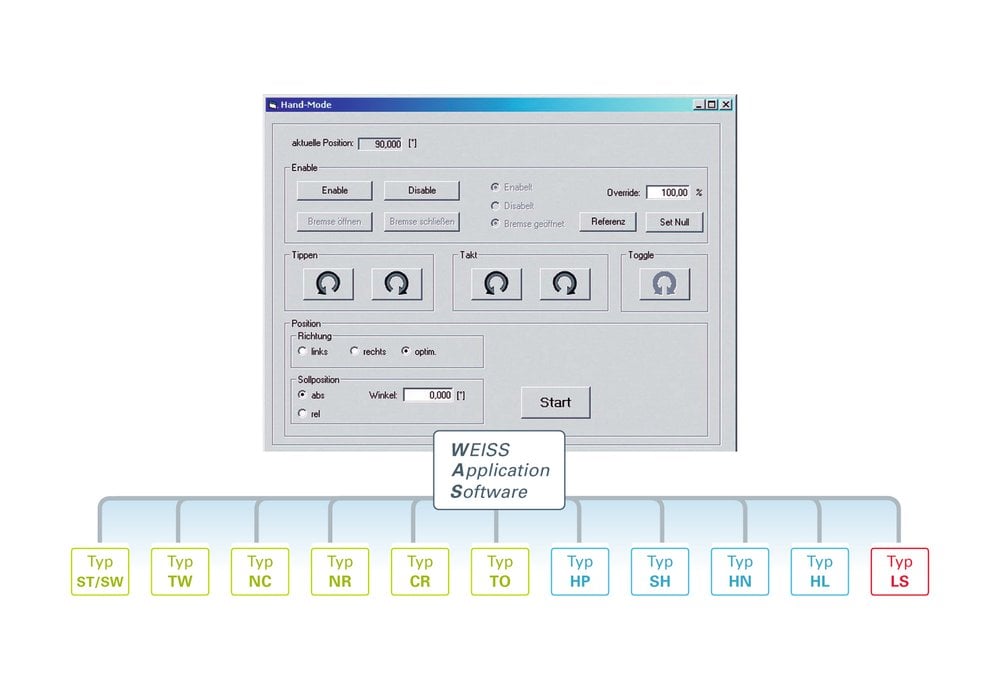www.industryemea.com
26
'10
Written on Modified on
WAS: as intuitive as smartphones
Weiss develops an intuitive user interface for its mechatronic products.

In pursuing its development strategy for mechatronic products, Weiss GmbH is placing more emphasis on the intuitive operation and easy configuration of its components and systems. As a leading supplier of rotary indexing tables and automation components for many years, Weiss (based in the town of Buchen in the Odenwald district of Germany) regards this decision as a logical extension of its commitment to product development in the recent decades.
In the past the company has devoted considerable effort to meeting global requirements for automation, developing solutions that offer high yield efficiency combined with high versatility and reusability to allow them to be quickly and easily reconfigured for new product versions without long setup or conversion times. This objective was attained by the interdisciplinary integration of the company’s expertise in various processes and capabilities. The merger of these different disciplines – mechanical engineering, electrical engineering and information technology – has led to the development of products featuring extremely high performance combined with complexity and sophistication.
“Right from the start, we focussed on developing intelligent components, with products that can properly handle one-off lots while at the same time offering ease of use for operators lacking interdisciplinary skills and easy integration into operational processes. With regard to a self-explanatory, intuitive operator interface for a complex technology, we more or less took our cue from smartphones”, according to Uwe Weiß, managing partner of the company.
The company developed its own application software, dubbed ‘WAS’ for ‘Weiss Application Software’, to provide an elegant solution to the requirements for the human–machine interface – an intelligent, Windows-based user interface for generating and configuring motion control programs for all Weiss user-programmable products. In a manner of speaking, the engineering effort normally necessary for integration has already been provided by the software.
WAS is especially beneficial for small and medium-size manufacturers of special-purpose machinery, who up to now have been compelled to outsource the development of control programs due to the absence of in-house expertise in this complex subject. WAS makes it easy for them to set up Weiss’ automation components themselves, either by entering paths, angles and ramps directly or by using the handy teach-in mode. WAS also supports large-scale users of Weiss components by helping them to reduce programming effort and thereby reduce the life cycle cost (LCC) of the system. Weiss’s user-programmable components drastically reduce the engineering effort necessary for initial configuration or reconfiguration to only 1 to 2 man-days.
Weiss’ product philosophy and commitment to ease of use also support firms that wish to satisfy the needs of their customers with regard to flexibility and output without being forced to maintain multidisciplinary expertise in house for this purpose. It also protect these firms against unforeseen costs during the integration of Weiss components into their systems.
In the past the company has devoted considerable effort to meeting global requirements for automation, developing solutions that offer high yield efficiency combined with high versatility and reusability to allow them to be quickly and easily reconfigured for new product versions without long setup or conversion times. This objective was attained by the interdisciplinary integration of the company’s expertise in various processes and capabilities. The merger of these different disciplines – mechanical engineering, electrical engineering and information technology – has led to the development of products featuring extremely high performance combined with complexity and sophistication.
“Right from the start, we focussed on developing intelligent components, with products that can properly handle one-off lots while at the same time offering ease of use for operators lacking interdisciplinary skills and easy integration into operational processes. With regard to a self-explanatory, intuitive operator interface for a complex technology, we more or less took our cue from smartphones”, according to Uwe Weiß, managing partner of the company.
The company developed its own application software, dubbed ‘WAS’ for ‘Weiss Application Software’, to provide an elegant solution to the requirements for the human–machine interface – an intelligent, Windows-based user interface for generating and configuring motion control programs for all Weiss user-programmable products. In a manner of speaking, the engineering effort normally necessary for integration has already been provided by the software.
WAS is especially beneficial for small and medium-size manufacturers of special-purpose machinery, who up to now have been compelled to outsource the development of control programs due to the absence of in-house expertise in this complex subject. WAS makes it easy for them to set up Weiss’ automation components themselves, either by entering paths, angles and ramps directly or by using the handy teach-in mode. WAS also supports large-scale users of Weiss components by helping them to reduce programming effort and thereby reduce the life cycle cost (LCC) of the system. Weiss’s user-programmable components drastically reduce the engineering effort necessary for initial configuration or reconfiguration to only 1 to 2 man-days.
Weiss’ product philosophy and commitment to ease of use also support firms that wish to satisfy the needs of their customers with regard to flexibility and output without being forced to maintain multidisciplinary expertise in house for this purpose. It also protect these firms against unforeseen costs during the integration of Weiss components into their systems.

